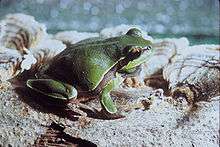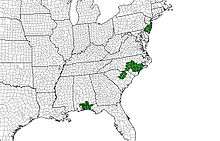Pine Barrens tree frog
The Pine Barrens tree frog[1] (Dryophytes andersonii) is a species of New World tree frog. It is becoming rare due to habitat loss.
| Pine Barrens tree frog | |
|---|---|
 | |
| Scientific classification | |
| Kingdom: | Animalia |
| Phylum: | Chordata |
| Class: | Amphibia |
| Order: | Anura |
| Family: | Hylidae |
| Genus: | Dryophytes |
| Species: | D. andersonii |
| Binomial name | |
| Dryophytes andersonii (Baird, 1854) | |
| Synonyms | |
| |
Physical characteristics
Dryophytes andersonii, only about 1–3 inches (25–76 mm) long, is one of the smaller species of tree frogs. Members of the species are predominantly green, with wide, dark stripes. They often have spotted, orange-gold markings on the hidden surfaces of their legs and tend to have large toe pads.
The key to distinguishing the Pine Barrens tree frog from the similar-appearing American green tree frog (D. cinerea) is the white-bordered lavender stripe on each side of the body in the Pine Barrens tree frog. D. cinerea has only a white stripe in this location.
Habitat
Dryophytes andersonii is most commonly found in brushy areas, often near peat bogs or shallow ponds. They usually inhabit areas carpeted with thick moss. Adults are terrestrial, but tend to reside near water sources. Unlike most frogs, they are tolerant of low pH levels, and often lay eggs in shallow, acidic ponds. The ideal pH level for D. andersonii eggs is between 3.8 and 5.9.
Distribution

Due to the limited extent of suitable habitats, Dryophytes andersonii is currently distributed in three disjunct areas in the southeastern United States: the New Jersey Pine Barrens; the Sandhills of North and South Carolina; and the Florida panhandle and southern Alabama. Although one specimen of D. andersonii is known from Georgia, a population is not known to currently exist there.[2]
Dryophytes andersonii is the state amphibian of North Carolina.[3]
Conservation status
Dryophytes andersonii was listed as endangered by the US Fish and Wildlife Service between 1977 and 1983, when additional populations were found in Florida.[4] The IUCN has classified it as Near Threatened as of 1996.[5]
In popular culture
The Pine Barrens tree frog was featured in a series of prints by artist Andy Warhol. In 1983, the artist was commissioned to create a portfolio of ten endangered species to raise environmental awareness and included was D. andersonii.[6]
References
- Hyla andersonii, Amphibian Species of the World 5.6
- Hammerson (2004). "Hyla andersonii". IUCN Red List of Threatened Species. 2004. Retrieved 5 May 2006.CS1 maint: ref=harv (link) Database entry includes a range map and justification for why this species is near threatened. RangeMap:
- Horton, Emily. "Pine Barren Tree Frog". NCpedia. Retrieved 19 January 2014.
- "Pine Barrens treefrog (Hyla andersonii)". Environmental Conservation Online System. US Fish and Wildlife Service. Retrieved 20 January 2012.
- Hammerson, Geoffrey. "Hyla Andersonii". IUCN Red List of Threatened Species. Retrieved 20 January 2012.
- Warhol, Andy. "Pine Barrens Tree Frog 294". Endangered Species. Retrieved 14 July 2020.
External links
| Wikimedia Commons has media related to Hyla andersonii. |
